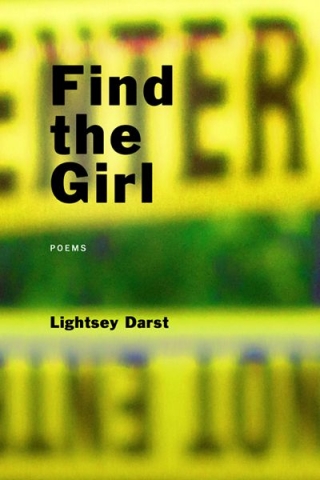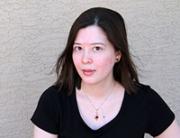 Originally from Tallahassee, Lightsey Darst writes, dances, writes about dance, and teaches in Minneapolis. She also hosts the writing salon “The Works.” Her writing has been awarded a 2007 National Endowment for the Arts literature fellowship as well as two Minnesota State Arts Board grants, and has been published in Gulf Coast, DIAGRAM, Antioch Review, and Verse Daily, among other journals.
Originally from Tallahassee, Lightsey Darst writes, dances, writes about dance, and teaches in Minneapolis. She also hosts the writing salon “The Works.” Her writing has been awarded a 2007 National Endowment for the Arts literature fellowship as well as two Minnesota State Arts Board grants, and has been published in Gulf Coast, DIAGRAM, Antioch Review, and Verse Daily, among other journals.
Darst is the author of a chapbook, Ginnungagap (Red Dragonfly Press, 2009), as well as Find the Girl (Coffee House Press, 2010). Her debut, described as “a poetic exposé of girlhood, obsession, and the CSI industry,” explores violence against young women through the prism of history, mythology, fairy tales, rich botanical imagery, and contemporary cases. Her website is www.lightseydarst.com.
TriQuarterly Online: You once remarked that “any life, any death must be imaginable, and must be imagined.” How does one walk the tightrope between tribute and appropriation?
Lightsey Darst: Debate about this is raging on the Internet, and you could spend your life reading and answering all the comments. For myself there are no hard-and-fast lines. All art is going to appropriate to some degree, and any tribute is going to look like appropriation to someone.
I actually wasn’t at all worried about this with Find the Girl—I knew my closeness to the material and I felt (and feel) an instinctive right to the territory. I know not everyone will agree with me on that, but that’s art (and life).
My current project, though, is all about other people’s pain, and I’m using a lot of collage, so I think about this quite a bit. My personal rules are that I have to treat heartfelt utterances with respect, I have to be using materially differently from my source, and I have to pay attention to how I’m treating members of different groups (e.g., am I making all lower-class white people sound like hayseeds?). I try to keep an eye on myself, to keep examining what I’m doing. It’s all judgment, though.
TQO: Neruda’s image “barbarous gold” seems especially apt for your debut, which combines images of nature with crime scenes; there is often an extravagance at work. Was it challenging to avoid beautifying the reality of these adolescents’ lives? Or was it the reverse—an intentional search for beautiful language despite the visceral circumstances?
LD: In Find the Girl I’m trying to simultaneously use and comment on the aestheticization of violence against girls. Use it to draw the reader in, then twist it to expose it—it’s a tricky play, and not everyone is going to think I made it.
Something else is going on, though, which is that I wanted to give these girls a way to be beautiful (something that is, after all, of great importance to many women and girls) that doesn’t revolve around men. That’s behind the final description of Helen in “Digging at Sparta,” in which the most beautiful woman in the world has two heads.
TQO: Is writing about violence much more simple/complex than it seems?
LD: I believe in writing for yourself—writing what you want or need to read. If you want or need to read about violence, so be it: that’s where you go. But there’s another side to this, which is that to some degree we form our tastes; we form what we want to read. In that sense, yes, I think one should attempt to be responsible, to try to keep one’s taste from veering toward the pornographic (which has nothing, by the way, to do with subject; poems that end with an “ah” are some people’s pornography). But there’s nothing absolute here. For me, writing needs a dangerous edge, needs a risk—whether that’s the risk of aestheticizing violence, of being disgusting, sentimental, hard to understand, formless, silent, strident, whatever. Doesn’t matter what’s at stake, but I’m far less interested when the stakes are low.
TQO: Are we becoming desensitized?
LD: There are always some things we see better than other things. It’s valuable cultural work to nudge those perceptions—to make people see what they don’t, whatever that is.
TQO: Readers (and writers) who fear the taboo could view Find the Girl as unsettling. What encourages you to push boundaries, whether those of others, or your own?
LD: If you find a boundary—in yourself, in others—you’ve got to push it. (I’m speaking of artwork here; I’m not talking about behavior, about life.) Maybe you’ll push it and nothing will happen, but at least then you’ll know.
Trisha Brown once called the first thirty or so years of her career “my apprenticeship in choreography”—years that were full of acclaim, years that bear no outward resemblance to apprenticeship. But look at the work and you’ll see a relentless testing of boundaries. She’s asking herself, so what’s this thing about movement? what’s this thing about being onstage? She pushed in every direction, and that’s how she came to feel that she knew her art—not that her art isn’t still evolving. Now isn’t that a fantastic prospect—a lifetime of exploration? That’s what you get if you purposefully, systematically push the boundaries.
But I’m cheating a little; you asked me about content. The thing is, content is just another parameter. I think pushing content boundaries is (artistically) the same as pushing formal boundaries—which I also attempt to do.
Again, cheating the question. I do, for some reason, gravitate toward garish content. I’ve blamed this on growing up in the South before, but who knows, really.
I did sometimes worry what people would think of me when I was working on Find the Girl. But that was a small personal worry. Mostly I was swept up in the desire, the writing of what I wanted to read.
TQO: What was the most enjoyable aspect of working on this book?
LD: What wasn’t? I loved this thing all the way along (god, am I allowed to say that?). That’s not to say I didn’t have stretches of confusion and frustration—thinking it was done when it wasn’t, wondering why I had to write about such embarrassing subjects—but when I look back on it, I feel a bit jealous of myself. There’s nothing like being caught up in your work.
Perhaps the grim subject matter should make me answer a little more soberly, but I knew from the outset that I was on a salvage mission. I didn’t have to discover the stakes halfway along, as sometimes happens.
TQO: How do you maintain interest in long thematic sequences?
LD: I like the big scale. I think it’s partly because I started my writing career in fiction, partly because I read a lot of novels when I was younger, and partly because I see a lot of dance, a field in which the evening-length work, the immersive single experience, is the gold standard. For me—and I don’t mean to say this is right—single poems can feel escapist, glancing, like seeing a moment of dance through a keyhole. As a reader, I love to be sunk into something, to have time for a dream.
As a writer, I find that I need repetition in order to explore whatever formal element I’m playing with. If I make one work that deals with collage, what I have learned? But if I make three hundred (and then whittle those down to forty or so—my current writing task), I’ve learned a lot.
On the other hand, maybe I just don’t have the patience required for single poems—or the faith that a single gesture can be enough that you see in Chinese brush painting. Maybe I’ll learn to write single poems when I’m sixty.
TQO: Having been raised in the South and now living in the Midwest, do you find these geographies shaping your work?
LD: Yes, definitely. Place is very important to my writing, even to the point that if I’m in New York for a couple of days and write a bit, that writing is going to be different from what I do at home (even if it’s using the same content and following the same basic formal framework). And yes, I think you need to leave home, at any rate, to know it. I never thought of myself as southern until I left the South—I was surrounded by people more obviously southern than myself—but now that I’m away, I can see not what it is, because that is permanently mysterious, but its outline, let’s say, and I can see how important it is to me. The South is obviously the setting for most of Find the Girl, and it’s in the tone of the book as a whole. My current work is more influenced, though, by the Midwest, where I’ve lived for the past ten years.
The South and the Midwest are going to feel different for everyone, but for me, the South is a historical place. It’s where nothing can stay buried, where everything is haunted, where everything is constantly cycling through life and death and back again. The Midwest—which I don’t know nearly as well—is conscientious, progressive, neurotic, cursed by good intentions. One is not better than the other. For a writer, any place is a goldmine, provided you can get some critical distance from it—the distance of an exile or a stranger.
TQO: In addition to writing, you curate a writer’s salon and have previously curated the “What Light?” poetry contest on mnartists.org. Is participation in the larger community essential for writers?
LD: I’m not going to legislate for anyone else, but for me, yes, I have to support the community I want to be part of. Writing can be so lonely, and lonely writers can end up with such skewed views of the literary world. Being involved helps defuse jealousy and frustration. Besides, you meet so many interesting people and hear so many interesting ideas.
TQO: When reading the work of other writers, what qualities draw you? What excites you in a poem?
LD: Risk! Something has to be on the line. I like music, I like attention to form (whatever form it is), I like a line that sweeps me away with an emotional suggestion and a line that brings me back down to the nitty-gritty of trying to understand. I like a high-low mix. I like atmosphere, I like architecture. There’s so much in modern poetry that I like. People are doing amazing work. (Any list of names would leave out so many brave writers.)
What I don’t like is the pat poem, the poem that knows exactly what it is doing. I also don’t like the poem that is mainly an occasion for the poet to model the poet hat. Please, take off the poet hat!
TQO: What do you look forward to next?
LD: I’m in the midst of a hell-earth-paradise project, a real mess, a kitchen-sink project of collage and word games and visions and last words and bad jokes. Hell was a lot of fun to write; Earth is a grind, but it’s turning out mystical and bizarre, which I like. I haven’t begun Paradise yet, and I’m really curious to see how that turns out—what a secular vision of paradise can be.


